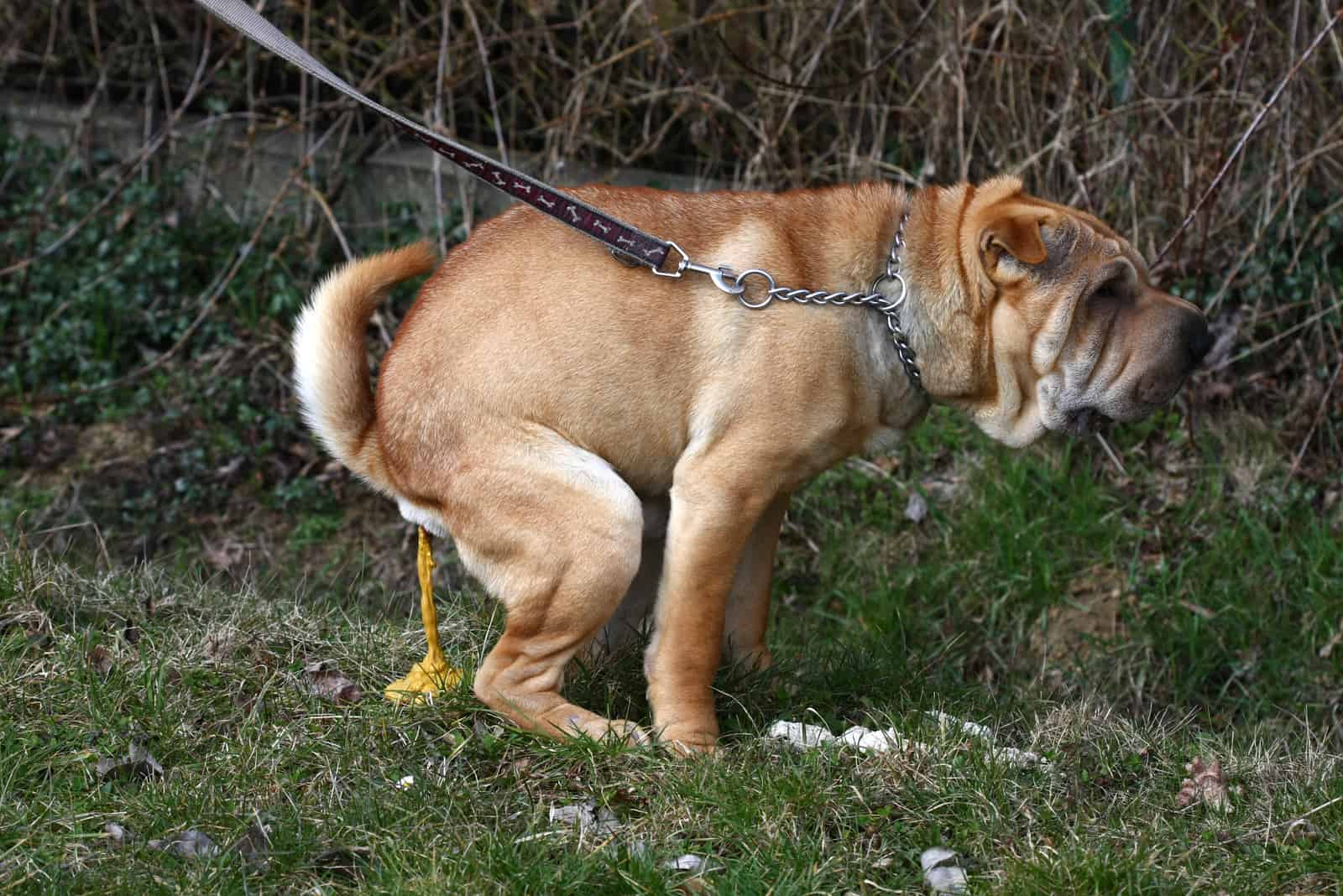Have you recently noticed your dog pooping clear liquid? Hold on, don’t panic! The solution to this problem may be easier than you think.
But, before we find the cure, we first have to put our minds on what could be behind your dog pooping clear liquid, right?
Well, today we are going to shed some light on this common, yet quite alarming problem that many dog owners struggle with. It’s time to talk about canine fecal matter. Yeah, that’s right, it is poo time!
Not sure if we can call it regular feces because your dog pooping clear liquid means that it is literally pooping out water. Come along with me, because I am taking you on a journey to the canine digestive system!
Is Dog Pooping Clear Liquid Normal?
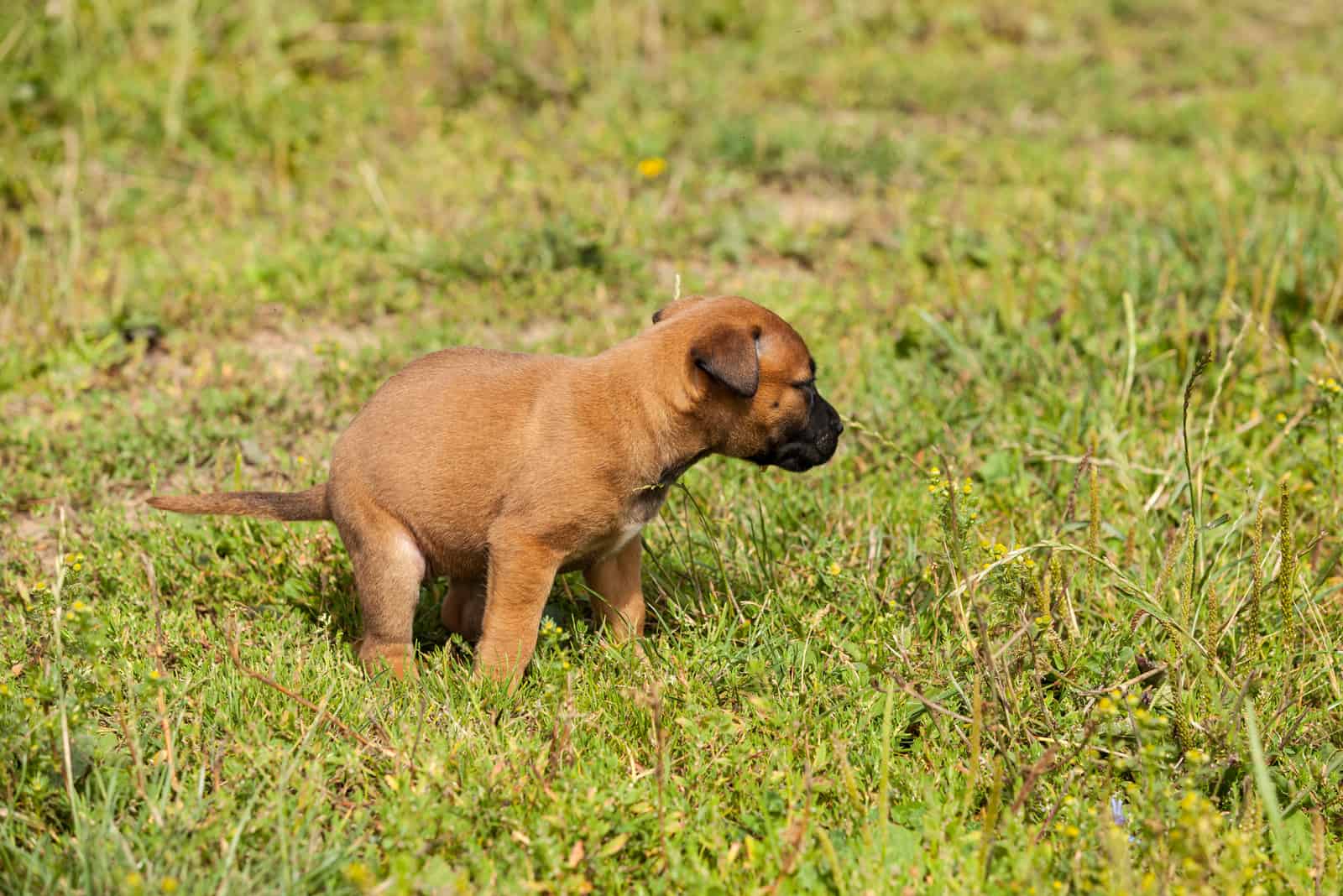
The answer to this question is quite simple – it is a big no! As responsible dog owners, we should all know what a normal dog poop consistency should look like. The dog poop color chart describes dog feces as something brown, not too hard, and not too soft — just fine.
So, Dog pooping clear liquid is far from normal, but it let’s not break our heads about it! Let me help you calm down – even though there are many causes behind your dog pooping clear liquid, the majority of them are harmless, especially if your dog pooping clear liquid is a one-time thing.
Is It Normal For My Dog To Poop Clear Mucus?
You may notice that your dog is pooping something that does not resemble water, but it does not resemble poop either. A mucus-like formation is getting out of its bum and you have no clue what it could be.
Clear mucus in dog poop leans more toward white color rather than transparent. It is normal for dogs to have some of this jelly-like consistency on the surface of their feces. Here’s what all dog owners should know – a small amount of mucus in a dog’s poop is all fine and dandy.
But, it is not normal for your dog to have all of its feces covered in clear mucus. Not only do dog owners notice excessive mucus in their dog’s feces during potty time, but they also notice clear mucus when their dog is not pooping. So, what gives?
Mucoid feces in dogs may suggest several health issues that are linked to the digestive system. Dogs that poop mucus usually suffer from large bowel inflammation (colitis) or irritable bowel syndrome (IBS).
Why Does My Dog Poop Look Like Water?
I hate to say this, but your dog has diarrhea and its gastrointestinal tract is not working the way it should. Let’s not panic now because that may not be a serious health issue that your dog is experiencing. Your dog’s poop may look like water if you changed his diet and it didn’t sit well with his stomach.
Alongside dietary change, your dog may have a high water intake which is making its feces all liquidy.
Now, you have to pay attention to the consistency and color of your dog’s watery poop. If your dog’s poop is as clear as water and does not have any foul odor, then you don’t have to worry about it. You may be surprised but your dog with diarrhea will act fine.
On the other hand, if your dog’s loose stool is very smelly and changes color to yellow, dark brown, or red, then you should call your veterinarian.
Smelly dog diarrhea is a major concern in many dog owners because it may indicate parvovirus (a life-threatening viral disease in small puppies).
Why Is My Dog Pooping Clear Liquid?
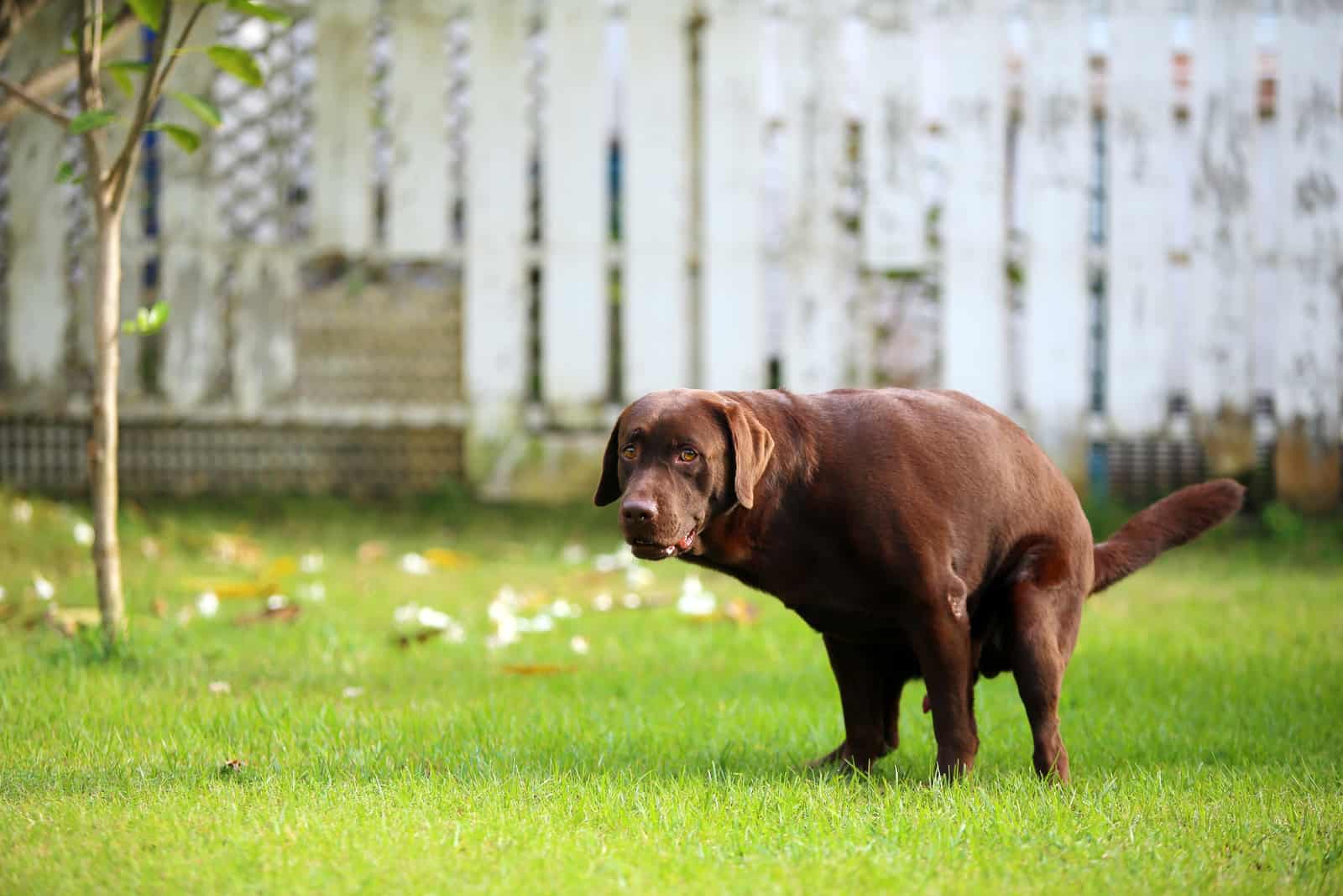
There are so many answers to this question and we will try to name each common cause of dog pooping clear liquid. Bear with us because this is going to be one smelly ride!
From dietary changes to serious health issues, your dog’s poop is going to tell us all about its health. Healthy dogs don’t poop clear liquid, but they may get into this awkward situation if their intestinal tract decides to go on a vacation!
Keep in mind that any of these common causes of dog pooping clear liquid can affect any dog breed. So, no matter what kind of dog you have, all of them are susceptible to digestive system problems.
1. Food Intolerance
Food intolerance occurs when you decide to change your dog’s diet or you feed it something that it should not eat. For example, dogs and blue cheese don’t get along very well. So, the chances of your dog developing diarrhea are pretty high.
This goes out to all forbidden foods and sudden dietary changes. It is not wise to make a quick switch from one dog food to another, let alone give your dog human food.
Dietary indiscretion is very common among our fluffy canine pals. It seems that they eat everything they get their little mouth on — that’s exactly what dietary indiscretion stands for. Dogs will eat cat poop, garbage, dead animals, or spoiled food as if it is some high-class buffet!
No wonder our canine friends get runny stools every now and then!
2. Food Poisoning
There is a thin line between food intolerance and food poisoning — both serve no justice to your dog’s gastrointestinal tract. Food poisoning is the most common cause of dog pooping clear liquid, bloody stools, and frequent vomiting.
Your dog’s poop color can take on numerous hues and shades, while its vomit color can be yellow, brown, transparent, or red.
Just like humans, dogs can get food poisoning from eating spoiled food or eating toxic human food such as poppy seeds or chocolate.
3. Food Allergies
Not all food is good for your dog’s gut. Many pooches are allergic to foods such as soy and wheat, while some may have unusual food allergies. I think the worst thing a dog can be allergic to is meat! And seriously they can be allergic to all sorts of meat.
Your dog can be allergic to store-bought dog food that contains the specific ingredient that triggers its immune system. When your dog’s immune system overreacts to that food ingredient, it manifests in all sorts of skin changes.
In addition to inflamed and itchy skin, a dog that is suffering from food allergies has clear or brown diarrhea, vomiting episodes, and lethargy.
4. Foreign Object Ingestion
Another very common case we see in the clinic is foreign object ingestion in dogs. Some cats happen to eat random objects too, but dogs are clearly winners. Our pooches like socks, balls, rubber bands, and sticks, and they don’t mind munching on them!
Many times dogs get random things stuck in their stomach, or in their esophagus. While foreign object ingestion usually causes blockage within the gastrointestinal tract, it can also lead to loose stools or watery diarrhea.
Dogs that have ingested an inanimate object also show signs of lethargy and depression, as well as dry heaving and vomiting attempts.
5. Dietary Changes
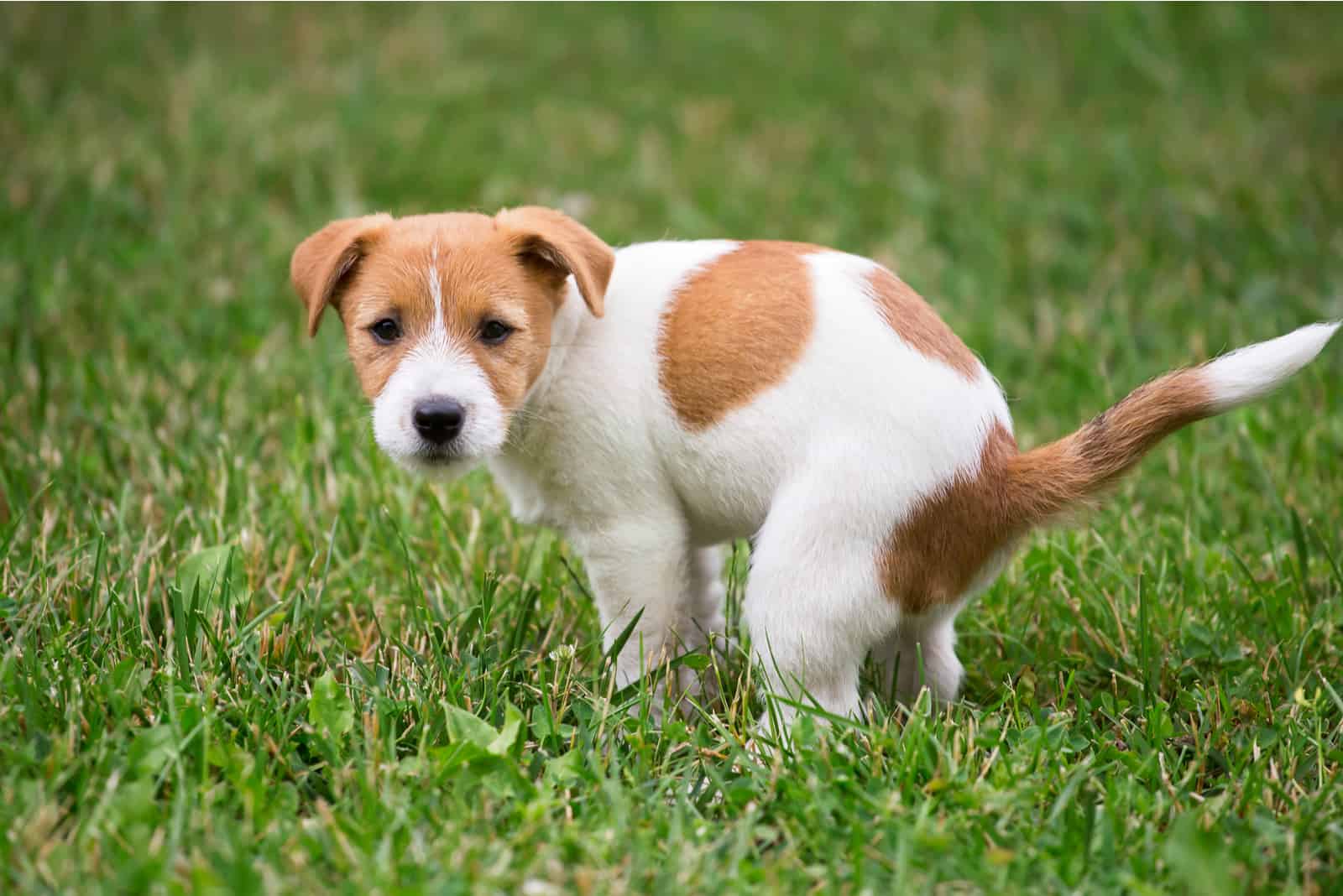
Most, if not all dog owners probably experienced their dog pooping clear liquid as a result of dietary change. A sudden diet change can cause an upset stomach, vomiting, and diarrhea in many dogs.
This is why reputable breeders and experienced veterinarians (DVM) recommend that you gradually change your dog’s diet in order for it to get used to new food. Not only does a sudden diet change cause dog pooping clear liquid, but it also makes your dog poop a lot.
If this is the case, then you don’t have to worry too much because dietary changes don’t leave long-term effects on your dog’s health.
6. Eating Cold Food
This is a very common problem that a lot of dog owners tend to overlook. Eating cold food can make your dog’s gut instantly worse. I mean, it can make your dog poop instantly, especially if it has a sensitive stomach.
Cold dog food shocks your dog’s gut and it may even cause it to vomit.
That said, it is best to serve your dog food that is not too cold and not too hot because both can cause stomach problems and loose stools.
7. Stress
Stress triggers lots of diseases and I think that we are all aware of that. Stress in dogs comes in all shapes and forms. It can be so subtle that we may not even notice that our Fido is stressed.
Luckily, our dog’s poop reveals if it has been going through a stressful period. If your dog is acting all fine and dandy but is pooping clear liquid, then it is probably because of stress and anxiety. Look back a bit and try to find out what may have caused your dog stress.
Many canines tend to eat too much or don’t eat at all when they are under stress, which leads to loose stools.
8. Intestinal Blockage
If you didn’t see your dog eat a foreign object, signs of dog intestinal blockage may be very similar to dogs who are experiencing an upset stomach. But, let me tell you, intestinal blockage A.K.A colonic obstruction in dogs is more serious than just an upset stomach. It is so serious that it often requires surgical procedures.
Intestinal blockage is commonly caused by foreign object ingestion in which a dog’s bowel movements are disrupted. The whole gastrointestinal tract slows down as it tries to work properly, but the foreign object is causing trouble.
These objects become lodged because they are unable to pass through the dog’s intestines. They can also cause stomach and intestine perforation which becomes a serious health issue.
9. Gastroenteritis
“Gastritis” stands for dog’s stomach inflammation and “enteritis” stands for dog’s intestine inflammation. So gastroenteritis in dogs describes gastrointestinal tract inflammation, and it ain’t good!
Gastroenteritis in dogs is followed by non-specific signs such as vomiting and pooping clear or tarry liquid. Don’t turn a blind eye to these signs because gastroenteritis can be a life-threatening condition, if not treated promptly.
If you don’t treat your dog’s gastroenteritis, then it can easily develop into acute hemorrhagic diarrhea syndrome (AHDS).
10. Colitis
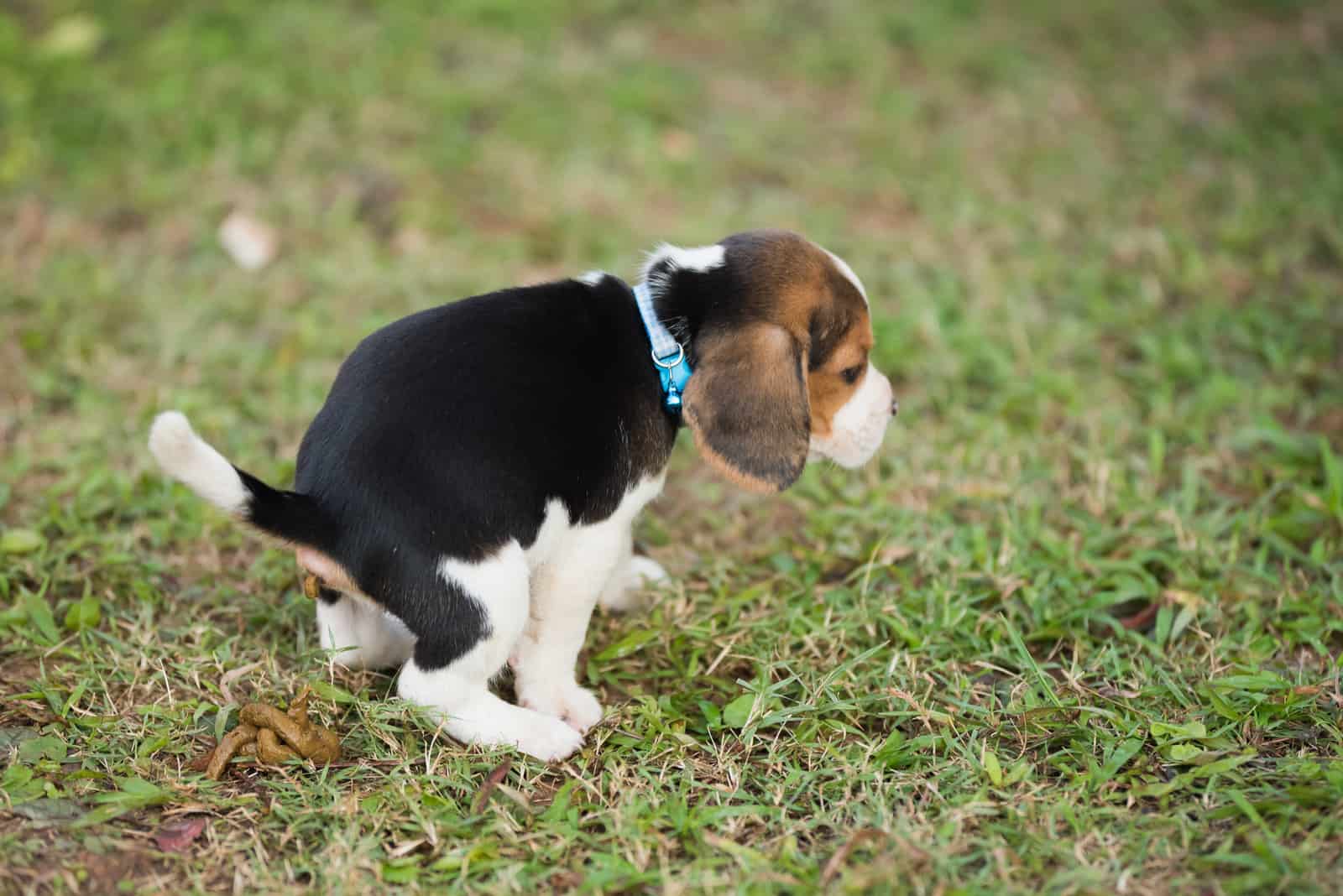
Whenever you see the suffix “-is” after some Latin word like the “colon”, know that it is about some kind of inflammation. So, colitis in dogs stands for inflammation of the large intestine, also known as the colon.
Even though colitis is most commonly found in adult dogs, puppies can also develop this health problem and have excessive diarrhea at night.
Dogs that are suffering from colitis may arch their back when pooping because of painful bowel movements. Many dog owners say that they notice small portions of bright red blood after their Fido is done pooping.
Many chronic colitis cases involve the presence of excessive mucus or fat.
The majority of canines with colitis will show signs of urgency and may throw up white foam. In addition to these signs, dogs with colitis frequently need to urinate.
11. Inflammatory Bowel Disease (IBD)
We have all been led to believe that Inflammatory bowel disease in dogs is a disease because it stands in the name. But, IBD in dogs is more like a syndrome because it is a group of signs that occur together.
IBD is very tricky because it is difficult for veterinarians to diagnose. The etiology (cause) of IBD in dogs remains unclear. Many vets and scientists believe that it is caused by bacterial infections, parasitic infestations, genetics, food intolerance, or maybe food allergies.
If you see your dog pooping clear liquid, vomiting, acting all weird, sleeping, and feeling lethargic, then you may suspect that it is suffering from IBD.
12. Irritable Bowel Syndrome (IBS)
It may sound similar to the previous health issue, but Irritable Bowel Syndrome in dogs is something else. While the etiology of this common dog’s gut problem also remains unknown, we have some speculations about what could be causing it.
Stress, food allergies, food intolerance, frequent dietary changes, genetics, as well as chronic illnesses can all contribute to the development of IBS in dogs.
In dogs with irritable bowel syndrome (IBS), the intestinal muscles don’t function properly, which is why dogs poop clear liquid. IBS can also lead to constipation.
Pooping clear liquid, upset stomach, vomiting yellow or brown, loss of appetite, and weight loss. are among the major IBS signs your dog may exhibit.
13. Pancreatitis
Introducing you to the inflammation of the canine pancreas — pancreatitis, a common problem that many dog owners are unaware of.
Dogs who suffer from pancreatitis experience an inflammatory response within the organ, which may cause loose stools, vomiting episodes, and stomach pain.
Watch out for loss of appetite and excessive diarrhea that can lead to dehydration. Your dog is going to lose lots of electrolytes and water which can put it in a life-threatening condition. But, that’s not all.
An enzyme within the pancreas is improperly and prematurely activated, causing the canine pancreas to begin digesting itself and causing inflammation.
Pancreatic tissue destruction releases toxins into the bloodstream, which can trigger an inflammatory response throughout the whole body, so it is important to act quickly.
14. Bacterial Infections
Most common gastrointestinal bacterial infections in dogs are the result of food poisoning. If the food that is contaminated with pathogenic bacterial strains such as Clostridium perfringens, Escherichia coli, Campylobacter spp, and Salmonella spp. gets into Fido’s digestive system, then prepare to go to war. These pesky bacteria don’t cause anything but trouble!
Bacterial infections of the gastrointestinal tract commonly cause your dog to poop clear liquid that gets very smelly too. Your dog can progressively lose weight and important electrolytes which can lead to a very weak immune system.
It may take some time for your dog to gain weight because it will be very weak after recovering from such a bacterial infection.
15. Small Intestinal Bacterial Overgrowth (SIBO)
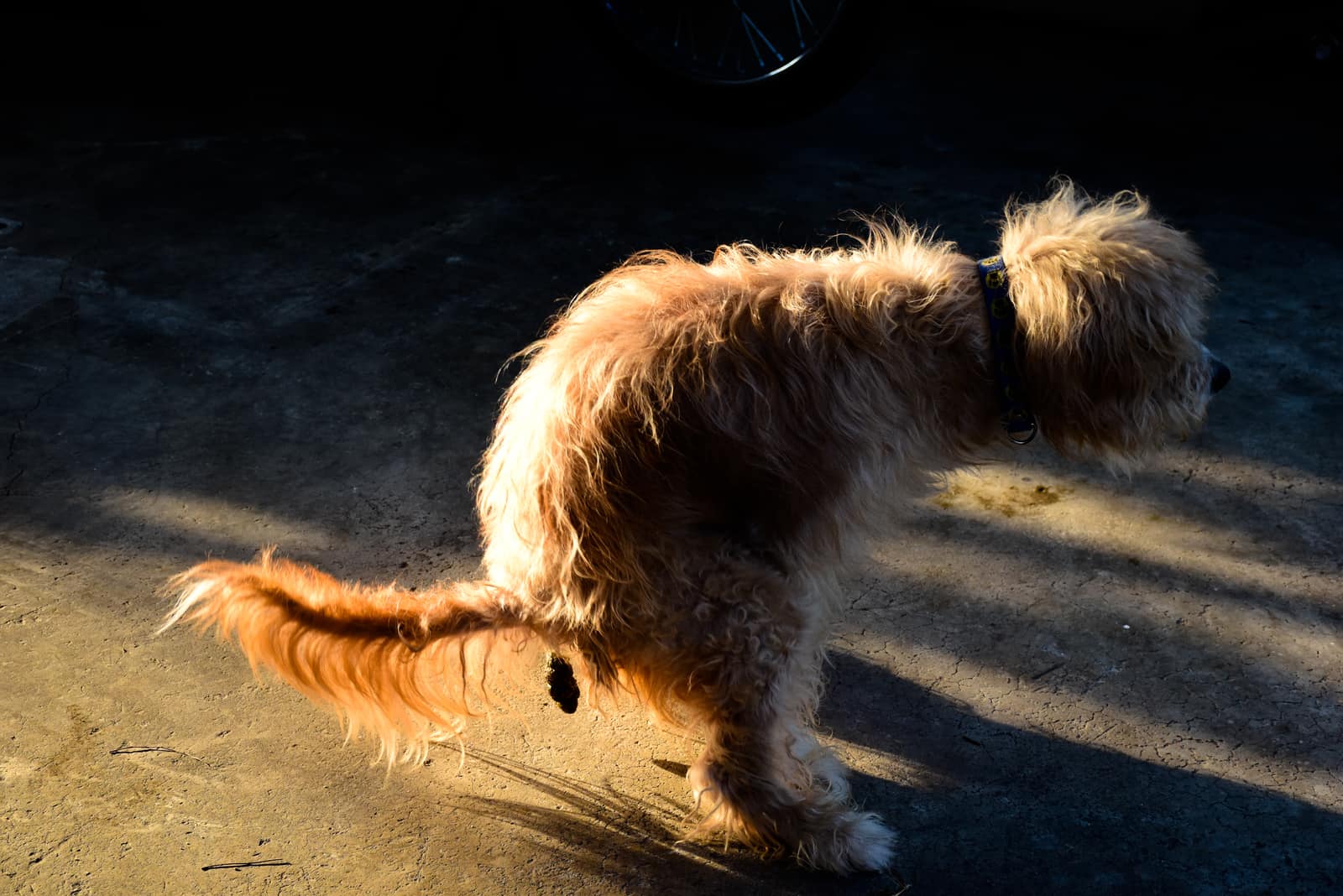
Small intestinal bacterial overgrowth (SIBO for short) in dogs describes an imbalance of good and bad gut bacteria. These bacteria are necessary for your dog’s normal digestion.
The bile acids necessary for the breakdown and absorption of fat are insufficient in canines that suffer from SIBO. This health problem causes foul-smelling and pale dog poop.
Veterinarians usually opt for antibiotics that are typical for treating bacterial overgrowth within the small intestine. most patients. Though treatable, canine SIBO is a condition that has a recurrence risk.
If canine SIBO is not treated, it can result in severe side effects like malnutrition, dehydration, and nutrient deficiencies.
16. Clostridial Enterotoxicosis
We’ve already mentioned bacterial overgrowth in a dog’s gut, so we might as well mention a specific pathogen bacteria that causes havoc in the digestive system.
Clostridial enterotoxicosis in dogs is commonly an acute health issue that affects the intestinal tract. This is also labeled as canine hemorrhagic gastroenteritis because it causes mucoid stools and even bloody diarrhea.
The pathogenic bacteria that is called Clostridium perfringens overgrows within the dog’s intestine, resulting in Clostridial enterotoxicosis.
You may want to think again about feeding your puppy raw food because this bacteria is frequently ingested through eating raw meat.
17. Parasitic Infestations
I will be honest with you, the majority of canine patients that were pooping clear liquid had some sort of internal parasites. I can’t blame the dog owners because many parasitic infestations in dogs progress without any signs until they become severe.
Dogs with severe internal parasitic infestation often throw up either yellow or foamy vomit that can contain worms — and they’re moving! Eww!
In addition to vomiting and having awful diarrhea, dogs that are suffering from a parasitic infestation often have bloated bellies and can’t seem to gain weight.
Giardia
Giardia is a protozoan parasite that affects both animals and humans — and no, it is not a worm. It is a microscopic little parasite that causes liquid diarrhea in dogs, as well as other animals, and humans!
Dogs that suffer from Giardiasis often exhibit soft, greasy stools that may alternate with diarrhea that is watery and occasionally foul-smelling.
Giardia is a tricky parasite that can contaminate anything it comes in contact with, including human or animal feces. In addition to contaminating basically everything, Giardia is super-contagious — even if your dog ingests small amounts of feces it can result in various problems.
You may notice that your dog farts too much – so much that the putrid smell almost makes you unconscious! Your dog has runny stools and its feces is smelly and greasy, and it floats. Your dog’s health and appearance worsen as Giardiasis progresses.
Giardiasis over time can also prevent the dog’s body from absorbing essential nutrients like vitamins, minerals, proteins, and fat.
Tapeworms
Dogs become infested with tapeworms when consuming food or water contaminated with tapeworm eggs or larvae.
Some dog tapeworm species have eggs that can migrate outside of the dog’s intestines and develop larval cysts in body tissues and organs.
Similar to other intestinal parasites in dogs, in order to survive, tapeworms take out all the nutrients from your dog’s body.
This is why your dog that is infested with tapeworms shows signs of nausea, depression, lethargy, weakness, and liquid diarrhea. To make things worse and yuckier, your dog’s poop has white specks in it!
This is the most common sign of tapeworm infestation in dogs, so you better pay attention to your dog’s poop!
Roundworms
Canines get roundworms from ingesting their eggs. Eggs of roundworms can be found in feces-contaminated soil. In other words, dogs that are already infested with roundworms poop on the ground where your dog comes over and accidentally ingests the roundworms’ eggs.
The dog’s mouth is one route by which the eggs can enter the body. Infested dog feces can then be passed from one pooch to another, and the infestation cycle continues.
Roundworms in dogs cause unusual bowel movements that you can literally hear. Additionally, vomiting and abdominal pain that are followed by liquid diarrhea are noticed in all dogs that are affected by roundworms.
But, did you know that roundworms can also cause dull and dry coats in dogs? Yep, the only logical result of excessive diarrhea and nutrients that roundworms take from the dog’s body is a dull coat, a skinny body, and a weakened immune system.
Canine roundworms have the potential to enter the lungs, which is why the dog might cough. The adult roundworms may be visible in your dog’s feces or vomit, but it is best that you take your dog’s fecal sample to the vet.
Whipworms
Similar to roundworms, consuming eggs from whipworms results in canine whipworm infestation.
Alongside contaminated dirt and soil, dogs may also eat unwashed raw vegetables that can carry whipworm eggs
Dogs can suffer from light or severe whipworm infestation so their symptoms can vary. The majority of dogs with whipworm infestations don’t exhibit any signs which can be misleading to dog owners.
However, dogs with heavy whipworm infestation may have painful, frequent bowel movements that result in smelly and bloody diarrhea. If the infestation is severe, whipworms can be found in your dog’s poop or vomit.
18. Viral Infections
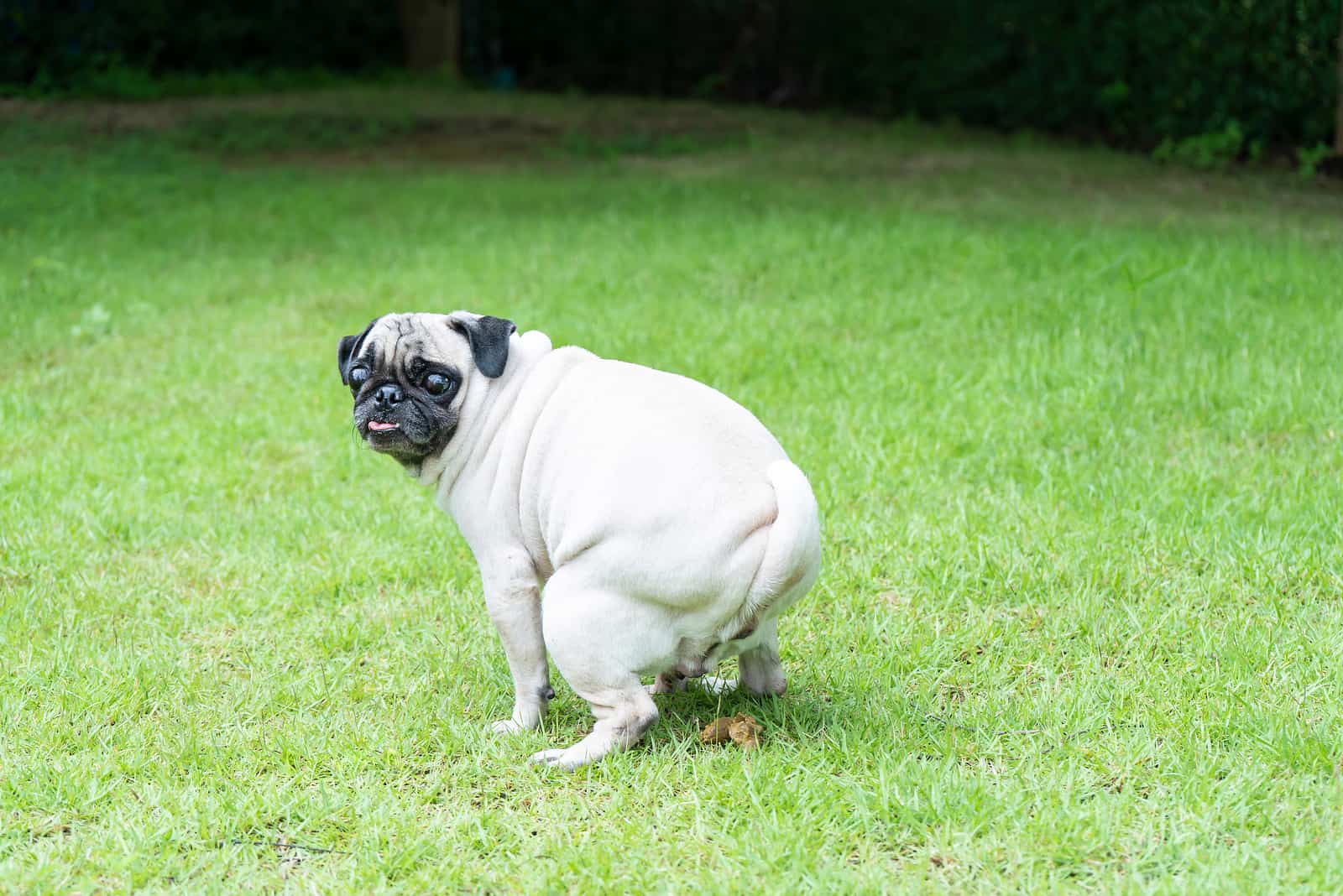
Viral infections in dogs are often linked to the respiratory system, right? Well, let’s talk about viral infections in the dog’s digestive system.
The most common term that you will hear is “viral gastroenteritis” which stands for inflammation of the lining of your dog’s digestive tract. There are various viruses that can cause digestive issues in your dog: from adenoviruses, and noroviruses, to rotaviruses.
Vaccinations against many canine viruses are available, but some puppies are not lucky enough and they pick up a viral stomach infection. The majority of pups exhibit vomiting and diarrhea as two major signs of viral gastroenteritis.
However, there is one particular viral infection that I really want you to focus on and that is the notorious parvovirus.
Parvovirus
Dogs can contract the highly contagious, potentially fatal parvovirus through contact with one another or contaminated objects.
Due to their immature immune systems, small pups are particularly vulnerable to contracting parvo. Most severely affected are young, developing puppies with intestinal parasites.
It’s crucial to understand that your dog is already seriously ill once they start exhibiting symptoms.
Contact your veterinarian right away if you notice that your puppy or adult dog is acting weird, feeling under the weather, and having bloody diarrhea that is profuse and awfully smelly.
Trust me, once you smell the awful stench of parvo, you will never forget it.
Because of the severity and lethality of parvovirus infection, it is crucial to immunize (vaccinate) your puppy against the parvovirus as soon as possible.
Learn more in our article on how I know if my puppy will survive parvo.
19. Fungal Infections
If you think that fungal infections in dogs only affect the skin, then think again! Fungi can actually do a lot of damage to your dog’s digestive system.
We are all focused on intestinal bacteria, parasites, and viruses, but we often overlook the risk of internal fungal infections in dogs.
Histoplasmosis
Canine histoplasmosis is a really harsh disease that can affect both lungs and the digestive system. Your dog may experience abdominal pain and diarrhea because these signs are the most typical of canine histoplasmosis.
But, it is difficult to tell whether or not Fido is suffering from colonic histoplasmosis because this disease shares a lot of stomach-related symptoms that occur in other digestive issues.
Perhaps we can find clues in the bloody diarrhea that is common in canine inflammatory bowel disease that we have previously described.
Dogs that are suffering from histoplasmosis may also experience persistent diarrhea with malabsorption and severe weight loss. Additionally, the dog’s temperature changes as it progresses into a high fever.
Mind you, canine gastrointestinal histoplasmosis is a rare condition that is almost exclusively present in hosts with compromised immune systems.
20. Intestinal Polyps And Tumors
Small growths known as bowel polyps can develop on the dog’s rectum or large intestine’s inner lining. Some dogs may have one intestinal polyp, while others may have more.
If your dog is suffering from long-lasting diarrhea or constipation, then it may be an indication of a larger colon polyp or even worse — cancer.
Dogs may develop small intestine cancer, which typically begins in the lining of the small intestine and has the potential to spread to other organs.
Canine intestinal tumors typically start in the duodenum or upper small intestine.
They can all lead to digestive system issues, runny stools, nausea, vomiting, and other common gastrointestinal signs we see in dogs.
What Are The Symptoms Of A Dog Pooping Clear Liquid?
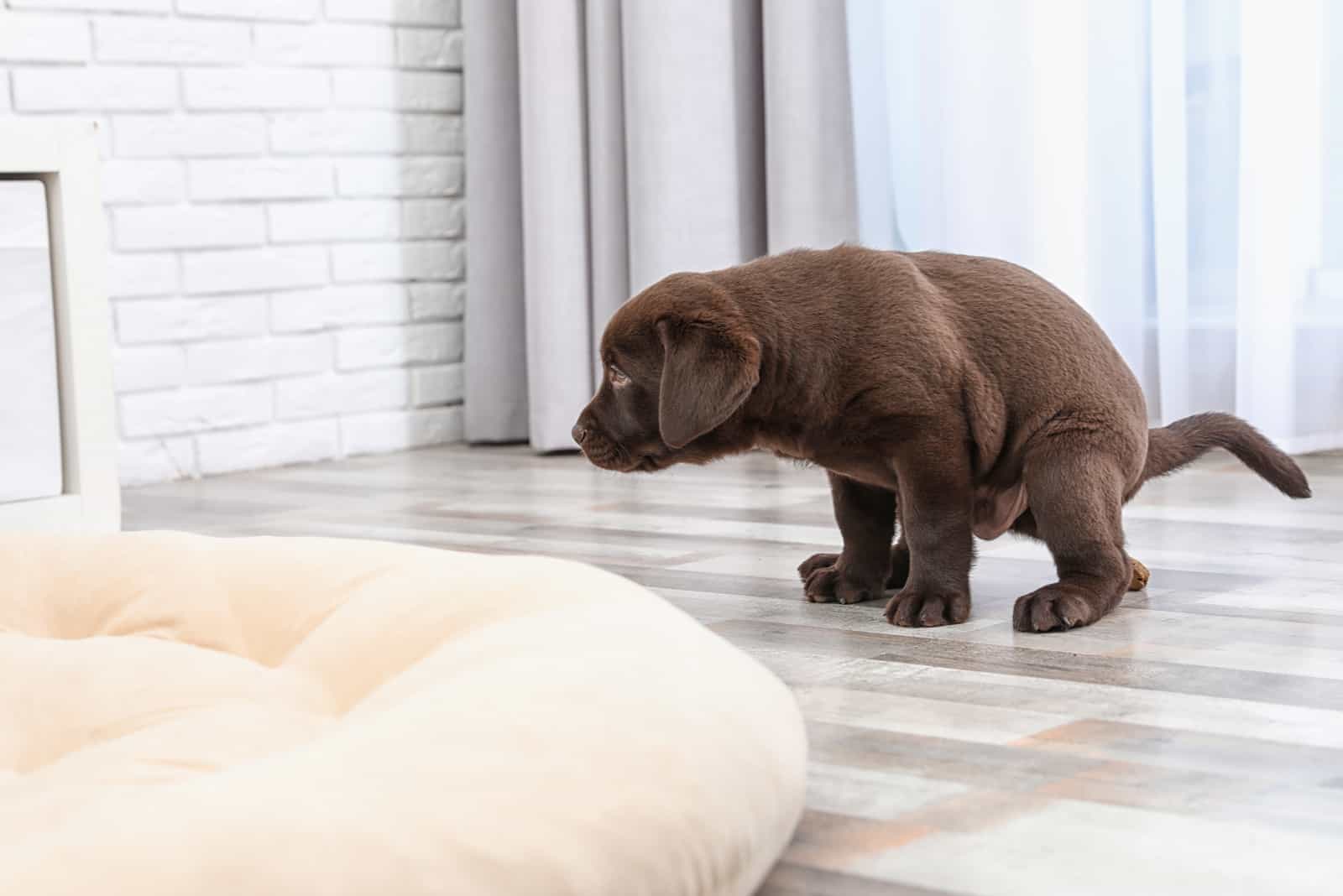
All gastrointestinal problems in dogs have at least two things in common: vomiting and diarrhea. Now, vomit color and diarrhea color can vary, but the majority of dogs with such health problems have no time to waste.
Excessive diarrhea and vomiting can cause your Fido to rapidly lose weight which can lead to dehydration and intestinal malabsorption.
The simple stomach flu can become a life-threatening condition to your dog if you do not treat it on time. Now, I am not saying this to scare you, but in a way, I do want you to take this seriously.
Do not ignore any of these symptoms when your dog is pooping clear liquid:
1. Weight loss
2. Change in poop color
3. Loss of appetite
4. Vomiting
5. Lethargy
6. Loose stools
7. Constipation
Many low-risk and high-risk digestive issues in dogs have these symptoms in common. So, it is best to approach each dog’s stomach problem as if it was the most serious and life-threatening condition (even though it does not have to be).
What To Do If My Dog Is Pooping Clear Liquid?
Now that you know why your dog is pooping clear liquid, it is time to take action. Remember to always pay attention to your dog’s pooping habits and the way its feces looks.
It can really tell you everything about your dog’s health and if you are not sure, you can ask your veterinarian to help you determine normal dog poop from abnormal dog poop.
So, if you happen to notice your dog pooping clear liquid for a day or two, make sure to do this:
1. Consult your veterinarian
2. Administer probiotics
3. Change diet
4. Keep an eye out on your dog’s stool
5. Regulate your dog’s water intake
I advise you not to give your dog any medication, vitamins, or supplements unless you have consulted your veterinarian.
Dogs’ stomachs are very sensitive and many mistakes can be made even when dog owners have the best intentions.
How Long Does Watery Diarrhea Last In Dogs?
There is no specific timeframe for how long watery diarrhea lasts in dogs but I can tell you that most of the time it does not last more than three days.
Depending on what caused it, watery diarrhea in dogs can last anywhere from a day to a couple of months. Chronic watery diarrhea in dogs usually does not have a good prognosis. In contrast to that, watery diarrhea that lasts for a couple of days, up to a week, is perfectly manageable.
Final Thoughts
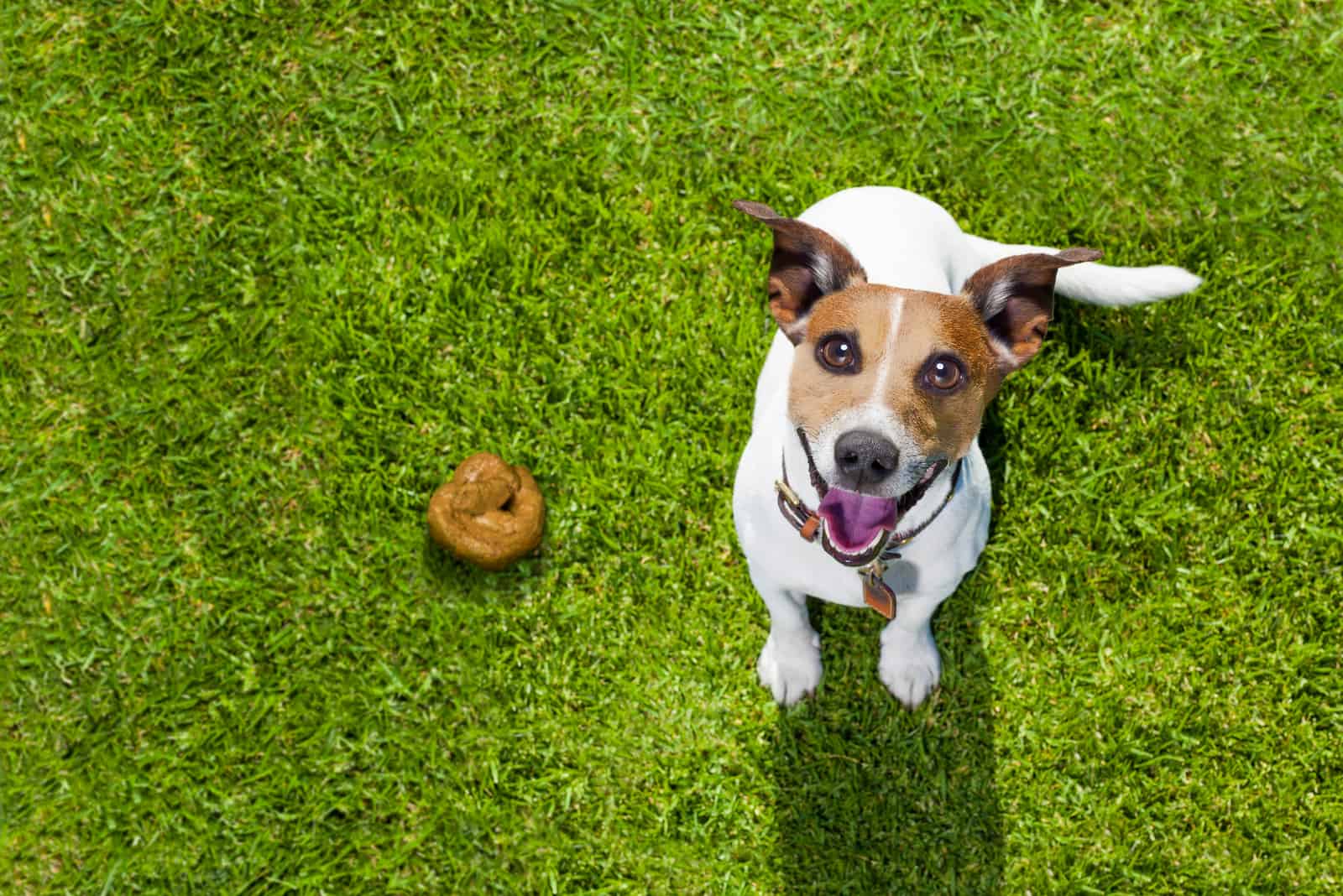
I know that it is not easy watching your dog pooping clear liquid. But, you are here, and you are doing your best to inform yourself about why this is happening.
Hopefully, this article will let you in on the most common causes of dog pooping clear liquid and what to do about it. Do not hesitate to call your veterinarian as soon as you notice any changes in your dog’s poop color, consistency, and viscosity.
As you can see, many gastrointestinal health problems in dogs share similar symptoms and it may be very difficult for you to figure out which one of them your dog may be suffering from.
That is why it is best to consult your veterinarian and ask them what you should do next. Your vet will probably suggest thorough blood work, as well as x-rays and deworming treatments. It all depends on what caused your dog to poop clear liquid in the first place.
Related Content
Will A Dog With Bloat Drink Water? Useful Tips
What Could Crusty Scabs Around Dog’s Mouth Mean? 9 Explanations
Infected Dog Spay Incision Healing Process: What Happens After Spay Surgery?
